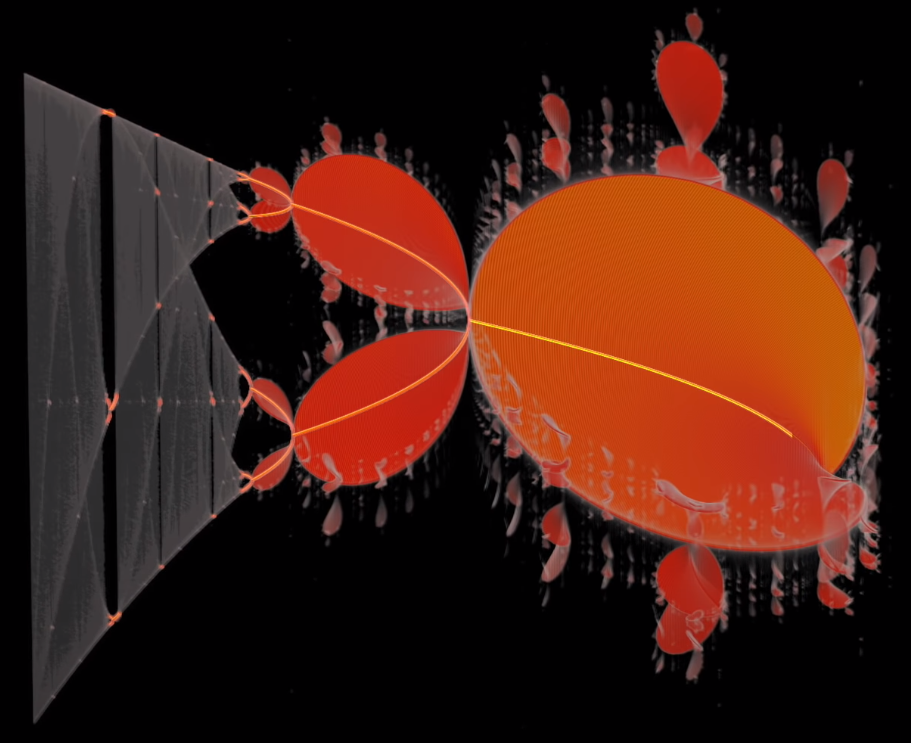I saw this video by Veritaseum, which talks about how the equation below, called the logistic map, connects a leaky tap, a population of rabbits, and the Mandelbrot set.
![]()

Before I explain why the logistic map is so interesting, we have to understand what the logistic map does.
Using the example of a rabbit population, the part ![]() refers to the change in population size as a percentage of the original,
refers to the change in population size as a percentage of the original, ![]() , and
, and ![]() is the growth rate. However, this equation would show that the population of rabbits skyrockets to infinity. To stop this, we have to use limiter
is the growth rate. However, this equation would show that the population of rabbits skyrockets to infinity. To stop this, we have to use limiter ![]() which multiplies
which multiplies ![]() by a decimal to slow down its growth.
by a decimal to slow down its growth.
To more recursions you take of the equation, the more you’ll see it stabilise at a particular value regardless of the initial population. Since the initial population doesn’t matter, the growth rate ![]() is where this gets interesting. In the lower values of
is where this gets interesting. In the lower values of ![]() the population will always go extinct but once
the population will always go extinct but once ![]() , the population stabilises at a positive value. But once
, the population stabilises at a positive value. But once ![]() , the population begins to jump between two separate points. If you were to graph
, the population begins to jump between two separate points. If you were to graph ![]() against
against ![]() , you’d get this:
, you’d get this:

This means that the population stabilises not at one single point, but two. This splits up once again into four different points and continues to double. Once ![]() , there’s no stable population and chaos emerges. This is a useful property and was first used to generate (pseudo) randomness from computers.
, there’s no stable population and chaos emerges. This is a useful property and was first used to generate (pseudo) randomness from computers.
Going back to the Mandelbrot set I mentioned, the way these two relate is that the logistic map is part of the Mandelbrot set. To see this, we have to view the set using the z-axis which gives us this image:

These unexpected relations have led me to the knowledge question, “To what extent do mathematical equations describe our world?” I feel that this question has no clear answer as it can be argued that math was invented than discovered. From this viewpoint, math doesn’t describe our world accurately as it was not part of this world in the first place and we merely use it to attempt to form some relation that we can then break down and analyse.
At the same time, math is widely used in all professions and is used extensively to create models or create products. Due to this, we have the potential ability to describe everything using a combination of numbers and algebra and could argue that math describes everything around us.
These two polar opposite arguments mean that your answer to this question is highly variable upon your view of the origin of mathematics. I personally feel that math is a useful tool to interpret our surroundings, but also that it shouldn’t be used to describe everything as there are aspects like emotions that cannot be quantified and attempting to do so would create a flawed model and would be counterintuitive.
The reason this is counterintuitive is that we’d model scenarios with a clear choice but due to the unpredictable nature of emotions, we may get a different outcome. This would cause a lot of headaches trying to figure out where the model went wrong despite the fact that we shouldn’t have modelled this in the first place.
Since the answer to my question is purely subjective and won’t have a consistent underlying reason, I’d be very interested to see your stance on this.
